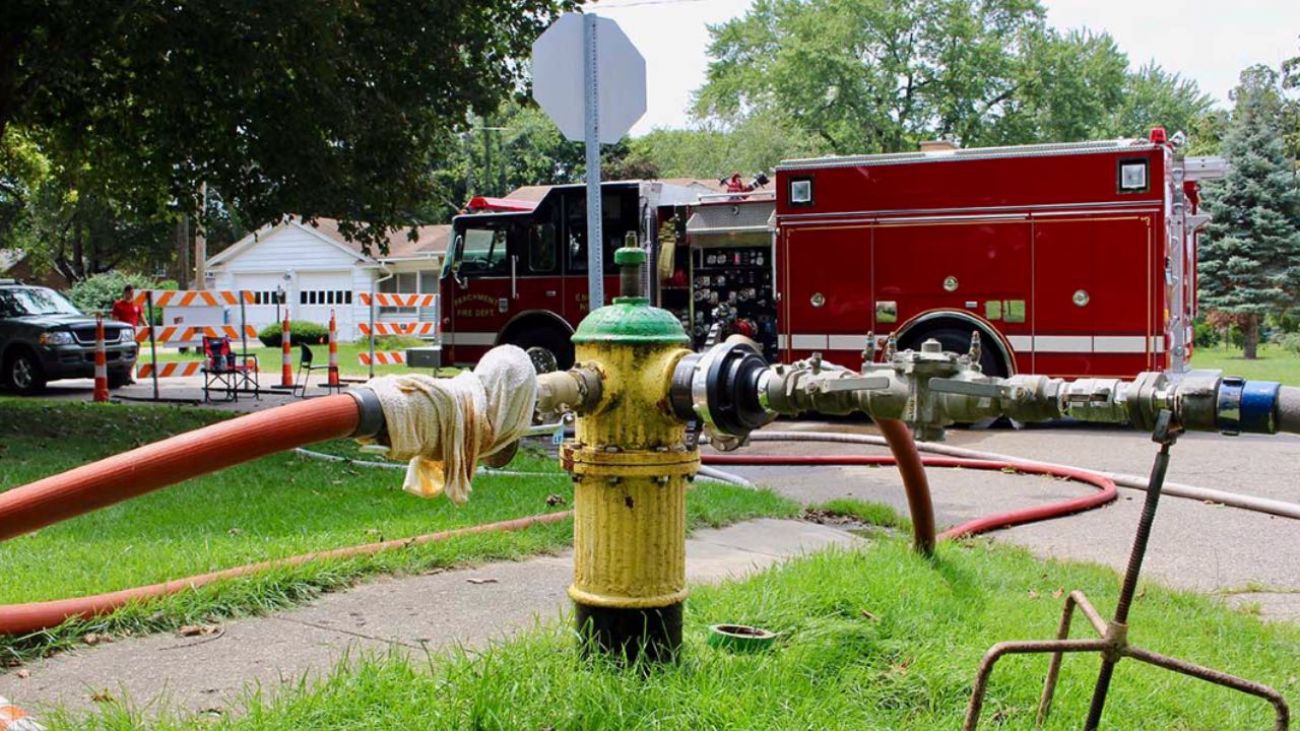Here’s what Gretchen Whitmer’s new PFAS water rules mean for Michigan

Michigan has taken a major step toward regulating dangerous PFAS chemicals in drinking water supplies.
Gov. Gretchen Whitmer last week formally proposed limits on seven types of PFAS that would apply to about 2,700 public water systems around Michigan. The announcement came seven months after she directed her Department of Environment, Great Lakes, and Energy (EGLE) and the multi-agency PFAS Action Response Team to draw up the science-based limits, which must undergo additional scrutiny before becoming final.
- Related: Environment roundup: Michigan punts on PFAS testing at dairy farm
- Related: Before debates, Gretchen Whitmer urges Democrats to protect Great Lakes
- Related: As PFAS fears spread, Michigan ramps up testing by zapping fish
Just four other states ‒ New Hampshire, New Jersey, New York and Vermont ‒ have adopted similar regulations for the “forever chemicals,” which are increasingly being detected in U.S. waters and are linked to serious health risks. Whitmer’s announcement comes as state leaders across the country are calling on the federal Environmental Protection Agency to regulate PFAS in drinking water nationwide — thus far to no avail.
“We can no longer wait for the federal government to act, which is why I directed EGLE to establish PFAS drinking water standards to protect Michiganders,” Whitmer, a Democrat, said in a statement Friday. “Moving forward with the rulemaking process moves us one step closer toward building public confidence and achieving real solutions that ensure every Michigander can safely bathe their kids and give them a glass of water at the dinner table.”
Here is a primer on the PFAS rules and what’s at stake.
But first, what are PFAS again — and how do they affect health?
Formally called perfluoroalkyl and polyfluoroalkyl substances, PFAS is an umbrella term for some 5,000 non-stick, waterproof and stain-resistant compounds that can also serve as fire retardants. The chemicals have been used in packaging and all sorts of everyday products. They may have been used or discarded at as many as 11,300 Michigan fire stations, landfills, industrial sites, military bases, airports and other locations, according to state estimates. Unlike some other chemicals, PFAS don’t break down in the soil or water, meaning the contamination lingers for decades — hence the “forever chemicals” nickname. At a minimum, trace amounts of PFAS flow in the blood of nearly every American, surveys suggest.
Researchers have linked the most-studied types of PFAS to developmental and behavioral problems in infants and children, hormonal and immunity problems as well as certain cancers. But scientists have closely studied only a tiny fraction of the different types of PFAS.
How much PFAS would be allowed in drinking water?
Because PFAS is potentially harmful at such low levels, scientists measure the chemicals in parts per trillion (ppt). Think of 1 ppt in the environment as a grain of sand in a swimming pool. Whitmer proposed limits on seven types of PFAS — each known by their own acronyms — as follows:
- PFNA — 6 ppt
- PFOA — 8 ppt
- PFHxA — 400,000 ppt
- PFOS — 16 ppt
- PFHxS — 51 ppt
- PFBS —420 ppt
- GenX — 370 ppt
The proposal also would require drinking water providers to regularly sample their systems for PFAS.
The agency had previously used an advisory level set by the EPA — 70 ppt of combined PFAS and PFOA — to determine when drinking water supplies might be at risk. Some drinking water systems took action based upon that standard, but it wasn’t legally enforceable, and many scientists criticized it as too lax, anyway.
Who is bound by the governor’s proposal?
The proposal covers about 2,700 public water supplies across Michigan, according to the administration’s Regulatory Impact Statement. That includes most municipalities and some schools and day care centers.. It also includes businesses with their own water supplies that don’t rely on municipal water — such as manufactured home communities, apartment buildings and industrial campuses.
The proposal would not directly regulate the roughly 1.12 million Michigan residents who draw water from their own wells — the state lacks jurisdiction to require such residents to test their own water. Once adopted, however, the new drinking water standard would change a groundwater cleanup rule adopted last year.
What happens to water systems that violate Michigan’s limits?
Water systems exceeding the new limits must publicly report that information, and state regulators could force them to comply, either by compelling them to install new treatment systems or taking other actions. But that process could take time. The proposal “does not stipulate a required strategy or timeline to return to compliance,” EGLE’s Regulatory Impact Statement says. The water supply would likely enter into an “Administrative Consent Order” with the state — a legal agreement to take certain actions to fix a violation.
“This process ensures an approach that balances the need to protect public health with the fiscal and technical realities the supply is facing,” EGLE said.
How many water systems exceed the limits now?
While Michigan has detected some level of PFAS in more than 100 water systems affecting 1.5 million people, just 22 have recently tested above some of the proposed PFAS limits, according to the EGLE’s Regulatory Impact Statement. Those systems are collectively treating just 930,000 gallons per day. For comparison’s sake, the Ann Arbor’s two treatment plants collectively handle 50 million gallons per day.
EGLE provided Bridge a list of the 22 systems where regulators recently detected PFAS above the proposed threshold. (View that list here.) It includes just two small municipalities — Plainwell in Allegan County and the Village of Hesperia in Newaygo County. Also on the list: five mobile home parks, five schools, three child care centers, a career technical center, and six other mostly industrial businesses.
Scott Dean, an EGLE spokesman, said investigations are still unfolding at some of the sites. Tri County Junior High School in Montcalm County recently installed a new well that has since brought PFAS levels below the proposed threshold, Dean said. And workers at the Tilden iron Mine in Marquette County — another site with PFAS levels above the proposed standard — mainly use the water for showering and other activities but not drinking.
Water supplies previously found to exceed the proposed threshold include the City of Parchment (Kalamazoo County), Plainfield Township (Kent County) and Ann Arbor — each of which are taking steps to filter their water or switch sources, meaning PFAS levels would now meet the proposed standard.
How much would the regulations cost? And who would bear the expense?
Water systems would pay for the regulations, meaning costs would be absorbed into utility bills.
The first year of sampling for PFAS under the proposal could cost $6.4 million across all 2,700 water systems, according to EGLE. But the agency says the cost will likely be lower in part because water systems with a good track record would not have to sample as frequently.
But water systems with too much PFAS would have to treat the water or switch sources — adding additional costs that could vary widely based upon the circumstances. One option would be to install a “granular activated carbon” (GAC) treatment system. That could collectively cost affected water providers $7.4 million upfront and $325,000 more each year thereafter — another “conservative” estimate, EGLE said.
Plainfield, population 34,000, is grappling from contamination from a nearby Wolverine Worldwide dump site. It’s installing a GAC system expected to cost $15 million. Ann Arbor spent about $1 million to upgrade filters in an already built system that treats water from the Huron River, which is polluted with PFAS.
The size — and cost — of upgrades to treat PFAS partly depends on whether a provider is treating groundwater or surface water, said Brian Steglitz, Ann Arbor’s water treatment manager.
“Most surface water plants are already situated with filtration. Not all groundwater treatment facilities need to have filtration,” he said, meaning groundwater facilities more often would need to pay more to build an entire treatment system, rather than just upgrade the filters.
(Steglitz said Ann Arbor most recently detected only one type of PFAS in its drinking water — at a level far below the proposed limit.)
Parchment, which provided water to 3,100 customers in town and nearby Cooper City, took another route after discovering high levels of PFAS in its water supply. It hooked up residents to nearby Kalamazoo’s systems. The estimated price tag was an initial $300,000 for the switch, and $216,000 a year for Kalamazoo’s water, according to MLive.
Steglitz said he hopes Michigan ultimately finds ways to require polluters themselves to bear the costs of treatment, though that issue lies outside of the scope of the proposed PFAS limits.
“There needs to be a recognition that there is a cost for compliance and for protecting public health,” he said. “Who should bear the cost? Should it be customers or the source of contaminants into our environment?”
Why is Michigan regulating just seven of the thousands of types of PFAS?
While generally applauding Gov. Whitmer’s proposal, some environmental groups have pushed for even stronger protections that would regulate PFAS as a class, rather than singling out seven types of the chemicals.
“If only a handful of PFAS are regulated, there will be swift regrettable substitution with other, similarly toxic PFAS - creating an ongoing problem where addressing one chemical at a time incentivizes the use of other toxic chemicals and we fail to establish effective safeguards to limit this growing class of dangerous chemicals,” scientists for the Natural Resources Defense Council, a national environmental group, wrote in a March report.
Michigan’s science advisory workgroup acknowledged other PFAS compounds are likely to have similar effects as the ones Whitmer proposes to regulate. But the workgroup said it lacked enough information to recommend health-based limits.
For other unregulated PFAS compounds, “additional monitoring, research for potential sources, notification of the public, and efforts to reduce exposure are warranted,” the workgroup wrote in a June report developed for the PFAS Action Response Team.
When might the proposal take effect?
The final rule could be adopted by April 2020, EGLE said. But it must first clear an administrative review that includes consideration by the Environmental Rules Review Committee, a controversial panel that GOP lawmakers created last year to check the governor’s power.
EGLE will launch a public comment period later this year.
Editor's Note: This story has been corrected to note that Tri County Junior High School recently installed a new well following a PFAS detection in its drinking water supply. An earlier version incorrectly stated the school had installed a filtration system. Additionally, EGLE estimated that water providers struggling to meet the governor's proposed PFAS regulations might collectively face $7.4 million in upfront treatment costs. A previous version of the story incorrectly applied that estimate to each water system.
Michigan Environment Watch
Michigan Environment Watch examines how public policy, industry, and other factors interact with the state’s trove of natural resources.
- See full coverage
- Subscribe
- Share tips and questions with Bridge environment reporter Kelly House
Michigan Environment Watch is made possible by generous financial support from:
Our generous Environment Watch underwriters encourage Bridge Michigan readers to also support civic journalism by becoming Bridge members. Please consider joining today.
See what new members are saying about why they donated to Bridge Michigan:
- “In order for this information to be accurate and unbiased it must be underwritten by its readers, not by special interests.” - Larry S.
- “Not many other media sources report on the topics Bridge does.” - Susan B.
- “Your journalism is outstanding and rare these days.” - Mark S.
If you want to ensure the future of nonpartisan, nonprofit Michigan journalism, please become a member today. You, too, will be asked why you donated and maybe we'll feature your quote next time!






